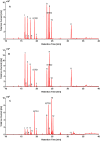Seedy Banana - A Source of Stilbenes and Flavan-3-ols
- PMID: 40474842
- PMCID: PMC12186517
- DOI: 10.1021/acs.jafc.5c01416
Seedy Banana - A Source of Stilbenes and Flavan-3-ols
Abstract
This study aimed at identifying the bioactive compounds in the seeds of three seedy banana varietiesMusa acuminata, Musa itinerans, and Ensete glaucum. GC-MS of extracts and NMR of isolated compounds were used for the identification of the components and GC-MS/FID was employed for quantification. The proportion of seeds in all samples was around 50% of the dried fruit weight. The seeds were rich in piceatannol, (+)-epiafzelechin, and epiafzelechin dimers. Piceatannol and epiafzelechin dimers were reported in seedy bananas for the first time. The highest piceatannol content was found in Ensete, accounting for 713 ± 71.9 mg/100 g dry weight (DW), followed by the seeds of ripe Musa acuminata and Musa itinerans at 440 ± 56.7 and 242 ± 17.4 mg/100 g DW, respectively. Musa seeds with a higher content of piceatannol had lower concentrations of epiafzelechin and its dimers, in the ranges of 287 to 553 mg/100 g of DW and 533 to 976 mg/100 g of DW, respectively. The content depended on maturity. Compared with ripe fruits, green Musas contained hardly any piceatannol and higher levels of epiafzelechin dimers. Gallocatechin was detected only in Ensete glaucum at 145 ± 19.7 mg/100 g of DW, and a major part of the phenolic compounds in g was found in the seed coat. The identified phenolic compounds in the seeds suggest that seedy bananas could be a potential new crop for food supplements.
Keywords: atropisomerism; bioactive compounds; biorefinery; epiafzelechin; phenolic compounds; piceatannol; seedy banana.
Figures






Similar articles
-
Sertindole for schizophrenia.Cochrane Database Syst Rev. 2005 Jul 20;2005(3):CD001715. doi: 10.1002/14651858.CD001715.pub2. Cochrane Database Syst Rev. 2005. PMID: 16034864 Free PMC article.
-
Investigation of the Potential of Commercial and Wild Passiflora Seed Species as Stilbenes Sources.J Agric Food Chem. 2025 Jun 18;73(24):15046-15055. doi: 10.1021/acs.jafc.5c00440. Epub 2025 Jun 6. J Agric Food Chem. 2025. PMID: 40476489 Free PMC article.
-
Etanercept and efalizumab for the treatment of psoriasis: a systematic review.Health Technol Assess. 2006 Nov;10(46):1-233, i-iv. doi: 10.3310/hta10460. Health Technol Assess. 2006. PMID: 17083854
-
Anti-interleukin-13 and anti-interleukin-4 agents versus placebo, anti-interleukin-5 or anti-immunoglobulin-E agents, for people with asthma.Cochrane Database Syst Rev. 2021 Oct 19;10(10):CD012929. doi: 10.1002/14651858.CD012929.pub2. Cochrane Database Syst Rev. 2021. PMID: 34664263 Free PMC article.
-
Variability in seed oil content, fatty acids profile, phytochemical properties, mineral and proximate composition of Iranian cultivars of vitis vinifera L.Sci Rep. 2025 Jul 2;15(1):23210. doi: 10.1038/s41598-025-06283-4. Sci Rep. 2025. PMID: 40603426 Free PMC article.
References
-
- Janssens S. B., Vandelook F., De Langhe E., Verstraete B., Smets E., Vandenhouwe I., Swennen R.. Evolutionary Dynamics and Biogeography of Musaceae Reveal a Correlation between the Diversification of the Banana Family and the Geological and Climatic History of Southeast Asia. New Phytol. 2016;210(4):1453–1465. doi: 10.1111/nph.13856. - DOI - PMC - PubMed
-
- Borborah, K. ; Borthakur, S. ; Tanti, B. . Musa Balbisiana Colla-Taxonomy, Traditional Knowledge and Economic Potentialities of the Plant in Assam. India; CSIR: New Delhi, 2016; Vol. 15, pp. 116–120.
-
- Bích, D. H. ; Chung, D. Q. ; Chuong, B. X. . Cây Thuoc Và Dong Vat Làm Thuoc O Viet Nam (Medicinal Plants and Medicinal Animals in Vietnam; Science and Technics Publishing House: Hanoi, Vietnam, 2006, pp 1138.
-
- Ali M.. Neo-Clerodane Diterpenoids from Musa Balbisiana Seeds. Phytochemistry. 1992;31(6):2173–2175. doi: 10.1016/0031-9422(92)80394-T. - DOI
MeSH terms
Substances
LinkOut - more resources
Full Text Sources
Miscellaneous

